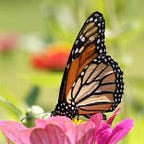FWS Scholar: Elizabeth Tsang
Elizabeth Tsang grew up climbing trees and catching salamanders in Floyd, Virginia, a small town nestled in the middle of the Appalachian Mountains. She spent most of her free time playing outside with her brothers and neighbors. Elizabeth also loved watching National Geographic on TV as early as the age of three which really helped her develop a deeper interest in the wildlife and plants around her beyond just a place to play. Her childhood connection with nature eventually led her to pursue a career with the U.S. Fish & Wildlife Service.
Elizabeth earned a B.S. in Wildlife Conservation at Virginia Tech. Immediately after graduating, she began a summer research project in the Virginia Tech Human Dimensions lab. She helped develop and test a web-based method for identifying and understanding stakeholders. In the Journal of Society and Natural Resources, Elizabeth recently published “A Web-Based Approach to Stakeholder Analysis for Identifying and Understanding Broader Constituencies in Wildlife Conservation.” With this method they were able to identify and describe the activities of over two hundred organizations that promoted wildlife viewing in Virginia, which created an opportunity for addressing geographic and programmatic gaps in the wildlife viewing plan.
Interested in contributing to research immediately applicable to conservation and management, Elizabeth’s human dimension project focused on creating an alternative method for identifying conservation constituencies and collecting data about their activities and interests. Many conservation agencies and organizations must adapt how and who they interact with in order to meet their missions in the face of changing social and ecological contexts for conservation. However, limitations and barriers including, lack of staff, time, and resources, have restricted the ability of these organizations to conduct stakeholder analyses in order to identify and understand their needs.
“I’m passionate about this research because of the potential it has to help agencies create inclusive opportunities in conservation and the outdoors for people of all backgrounds and interests. By better understanding everyone we serve and the differing ways they interact with nature and wildlife, we can begin to improve the way we engage with and gain the support of our many constituencies and to ensure that all may have the access and opportunities to experience the deep connection with nature that has transformed so many of us in the field of conservation,” Elizabeth shares.
While a student, she entered the Directorate Fellowship Program (DFP) with the U.S. Fish Wildlife Service. For her DFP internship, Elizabeth was stationed at the Bear River Migratory Refuge in Utah, and the focus was on urban community engagement. She established a new collaborative partnership with another organization in the surrounding area to create new opportunities for engaging people in conservation and outdoor activities. Additionally, she wrote an action plan with steps for the refuge to continue meeting their urban refuge goals and objectives in the future.
Currently, she is the Natural Resource Specialist at the National Bison Range in Montana where she does a mix of field biology and refuge management. Elizabeth loves the variety of work and diverse experience she has received from this position and values the broader perspective that comes with it as well as the opportunity to conserve habitat and protect wildlife.
“A typical day doesn’t seem to exist in this job, but the last two years I’ve done a mix of bird surveys, vegetation surveys, crane and duck banding, elk culling, heavy equipment operating, grant and protocol writing, EA writing and planning, environmental education, GIS mapping, prescribed burning, bison production counting, invasive species management, and any other odd jobs that come up.”
When she is not working, you can find her hiking or backpacking through the mountains, catching frogs and salamanders, playing soccer, painting and drawing, dancing, or reading.
To learn more about Elizabeth’s research check out her work, “A Web-Based Approach to Stakeholder Analysis for Identifying and Understanding Broader Constituencies in Wildlife Conservation.” Brought to you by the USFWS Conservation Library, #FWSScholar, #WeAreUSFWS.
